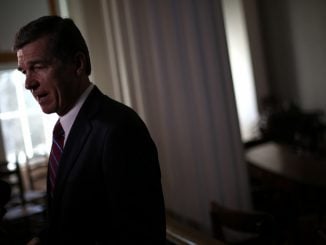RALEIGH — Amid the furor in reaction to the August 12 Charlottesville, Virginia rally in support of confederate monuments that devolved into wanton violence between ‘AntiFa’ counterprotesters and white nationalist event sponsors, and ultimately culminated in a deadly terrorist attack by a white supremacist, Gov. Roy Cooper has called for the removal of monuments honoring confederate soldiers and generals across the Old North State. The governor’s latest move was to advise the University of North Carolina system that they had the authority to remove a statue honoring the confederate dead who attended the school, despite a 2015 state law that specifically addresses the issue. Cooper was rebuffed when UNC announced the governor’s legal interpretation was not sufficient enough to constitute “clear legal authority to act unilaterally.”
“Some people cling to the belief that the Civil War was fought over states’ rights. But history is not on their side,” wrote Cooper in a statement released last week. “We cannot continue to glorify a war against the United States of America fought in the defense of slavery. These monuments should come down.”
One of those monuments, honoring the confederate dead, resides on the grounds of the Old State Capitol building, which is utilized as an office by the governor and a portion of his staff.
“Our Civil War history is important, but it belongs in textbooks and museums — not a place of allegiance on our Capitol grounds,” continued Cooper.
While protesters, led by an avowed communist and pro-North Korea Marxist, have already unlawfully torn down a confederate statue in front of the Durham County Courthouse, a 2015 law passed by the North Carolina General Assembly stipulates that local officials or state agencies cannot unilaterally remove memorials or monuments that “commemorates an event, a person, or military service that is part of North Carolina’s history.” Instead, approval for removals or locations of such monuments on public property must gain approval of the N.C. Historical Commission.
The law passed the N.C. Senate with unanimous approval of Democrats in that chamber, including former state senator and current N.C. Attorney General Josh Stein. It received just short of a super-majority in the N.C. House of Representatives.
After expressing concern for the “likelihood of protesters being injured or worse as they may try to topple any one of the hundreds of monuments in our state,” Cooper called for the repeal of the 2015 law.
“First, the North Carolina legislature must repeal a 2015 law that prevents removal or relocation of monuments,” said Cooper. “Cities, counties and the state must have the authority and opportunity to make these decisions.”
Despite the law Cooper penned a letter to UNC System President Margaret Spellings this week giving the University of North Carolina at Chapel Hill permission to remove a statue of a confederate soldier on its campus for reasons of public safety.
The statue, named Silent Sam, was donated to the university by alumni and the United Daughters of the Confederacy in 1913 to commemorate the 321 alumni who lost their lives in the Civil War. It has been a source of controversy for decades and has been vandalized multiple times including recently.
Cooper’s letter was reportedly in response to an appeal from University administrators, including Spellings, that voiced public safety concerns due to their belief protesters would tear the statue down.
The letter, also signed by local law enforcement, stated, “that it is only a matter of time before an attempt is made to pull down Silent Sam in much the same manner we saw in Durham. Based on our interactions with State and local law enforcement, including the State Bureau of Investigation, an attempt may occur at any time.”
Several of the more than 100 confederate monuments across the state have been vandalized or pulled down by protesters. A statue of Robert E. Lee displayed in the Duke Chapel at Duke University was damaged by protesters and subsequently removed by the University.
“If the University and its leadership believe such a dangerous condition is on campus, then the law gives it the authority to address those concerns. State law enforcement and emergency officials remain available to help and support the University as it navigates this process,” wrote Cooper in the letter.
The University announced late Tuesday that, upon the advice of counsel, it lacked the clear legal authority to remove the statue despite Cooper’s broad interpretation of the law.
The statue was surrounded by concentric barricades as rumors of a planned evening protest swirled around social media Tuesday.


